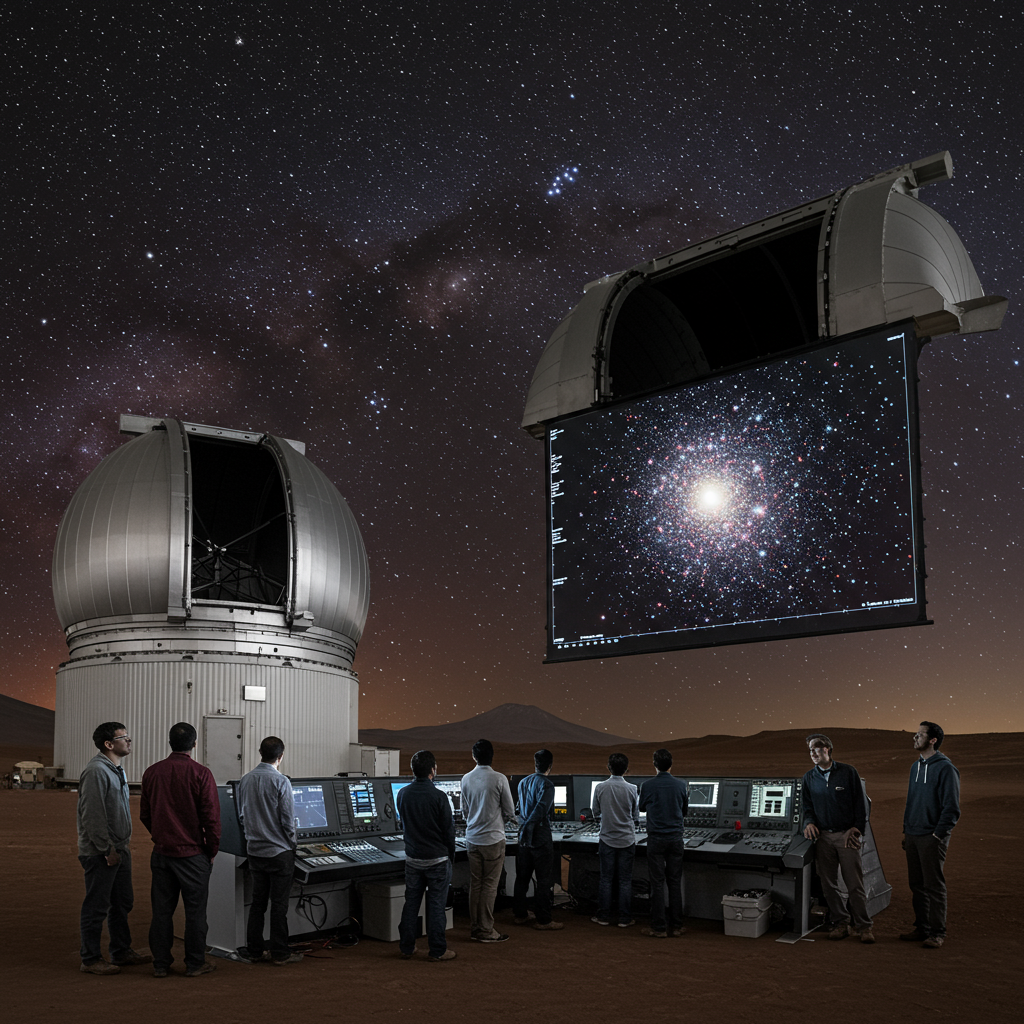The universe is vast and filled with cosmic treasures, none perhaps more stunning or mysterious than globular clusters. These ancient, spherical collections pack millions of stars into relatively small volumes, presenting a formidable challenge for astronomers trying to study individual stellar inhabitants. Excitement reached a fever pitch recently as the Vera C. Rubin Observatory (VRO), perched high in Chile’s Atacama Desert, released its first groundbreaking images and data. This revolutionary facility, housing the world’s largest digital camera, is just beginning its ambitious mission to map the dynamic night sky. early observations, including a close look at the dazzling globular cluster 47 Tucanae, are already proving the observatory’s immense potential to unravel long-standing cosmic mysteries, particularly those hidden within these dense stellar cities.
Navigating the Crowded Cosmos: The Challenge of Globular Clusters
Globular clusters are among the oldest structures in our Milky Way galaxy. They are dense, tightly bound groups containing hundreds of thousands, sometimes millions, of stars. These stars formed together around the same time, offering a unique window into early stellar evolution. The second-brightest globular cluster visible from Earth is 47 Tucanae (NGC 104), located about 14,700 light-years away. With millions of stars crammed into a core just a few light-years across, 47 Tucanae is an incredibly bright, yet intensely crowded, celestial object.
Studying individual stars within the core of a globular cluster like 47 Tuc is exceptionally difficult. The sheer density means countless stars appear blended together, even through powerful telescopes. Further complicating observations, especially towards the cluster’s outer edges, is the challenge of distinguishing cluster member stars from unrelated foreground or background stars in the Milky Way or even distant galaxies. Astronomers still have fundamental questions about these stellar behemoths, including their formation processes, potential links to dark matter distribution, their true physical extent, and whether some might be the stripped cores of smaller dwarf galaxies consumed by the Milky Way. The dense environment of 47 Tuc, for instance, makes it a prime candidate for potentially harboring an intermediate-mass black hole at its center, similar to what’s suspected for the much larger Omega Centauri cluster. Overcoming the observational challenges of these packed stellar environments requires cutting-edge technology and sophisticated analysis techniques.
First Light and Early Science: Testing the Vera Rubin Observatory
The Vera Rubin Observatory’s construction has been eagerly anticipated by the astronomy community for years. Equipped with an 8.4-meter telescope and the massive 3200-megapixel LSST Camera – the world’s largest digital camera – VRO is designed to survey the entire visible sky every few nights over a decade. This unprecedented effort is the Legacy Survey of Space and Time (LSST). Before LSST officially begins, the observatory undergoes a commissioning phase using smaller systems and early data collection periods.
One such early data collection, known as Data Preview 1 (DP1), utilized the observatory’s Commissioning Camera (ComCam), a 144-megapixel prototype of the full LSST Camera. Although primarily intended for testing and refining the telescope and its software pipelines, this early data proved to be of remarkably high quality. Researchers immediately recognized its potential for yielding genuine scientific results even before full operations commenced. Scientists are analyzing this preliminary data not just to understand how VRO performs, but to make concrete discoveries and test analytical methods crucial for handling the massive data flow expected from the full LSST.
Early Focus on 47 Tucanae
A recent research paper, “47 Tuc in Rubin Data Preview 1: Exploring Early LSST Data and Science Potential,” published in 2025 with lead author Yumi Choi from the National Science Foundation’s National Optical-Infrared Astronomy Research Laboratory (NOIRLab), specifically leveraged VRO’s early DP1 observations of 47 Tucanae. The goal was ambitious: to explore how well the observatory could resolve and characterize individual stars within this famously crowded stellar field.
The early VRO data on 47 Tuc came from four nights of observations using ComCam across standard multi-band filters (u, g, r, i, z) covering ultraviolet, visible, and near-infrared light. The researchers tackled the significant challenge of separating probable 47 Tuc members from the dense tapestry of background and foreground stars. By applying a sophisticated combination of filters based on stellar properties (isochrone analysis), precise stellar motions across the sky measured by the Gaia spacecraft (proper motion), and stellar colors (color-color space), they compiled a catalog of 3,576 probable member stars within the cluster’s field of view.
Demonstrating Capability: Stars, Variables, and Binaries
These initial analyses, using data from just four nights and a smaller camera, successfully demonstrated VRO’s capability to peer into the dense core of 47 Tuc. While acknowledging challenges, particularly near the extremely crowded center and due to contamination from stars in the Small Magellanic Cloud behind the cluster, the results were highly promising.
Beyond simply cataloging member stars, the researchers also tested VRO’s ability to detect variable stars and binary systems. Despite the “sparse temporal sampling” (meaning observations weren’t frequent enough to capture rapid changes), the ComCam data successfully identified known variable stars within the 47 Tuc field. This included recovering three RR Lyrae variable stars – standard candles often found in globular clusters – and two eclipsing binary star systems. Detecting eclipsing binaries, where one star passes in front of another from our perspective causing a dip in brightness, can be particularly tricky from ground-based telescopes, highlighting VRO’s potential even in its early stage.
The conclusion from this early work on 47 Tuc is clear: the DP1 data, despite its limitations, convincingly showcases the Vera Rubin Observatory’s immense potential. It proves its capability for detailed stellar population studies and variability analysis even in the most challenging, crowded stellar fields. The researchers noted that expected improvements to the Rubin Science Pipelines and dedicated software tailored for crowded-field photometry will likely deliver even higher-quality results with subsequent data releases (DP2 and DR1).
The LSST Vision: Revolutionizing Our View of the Universe
The study of 47 Tucanae is just a tiny fraction of what the Vera Rubin Observatory is designed to achieve over its 10-year Legacy Survey of Space and Time. LSST will repeatedly image a vast portion of the Southern Sky, creating an unprecedented dynamic map of the cosmos. This survey is poised to revolutionize almost every area of astronomy.
LSST’s primary scientific goals include shedding light on the mysteries of dark matter and dark energy, the elusive components that dominate the universe’s composition and drive its accelerating expansion. The observatory’s combination of wide field of view (imaging an area equivalent to about 45 full moons in a single shot) and deep, frequent observations will allow astronomers to detect the subtle distortions in galaxy shapes caused by dark matter’s gravity and track changes in cosmic distances caused by dark energy. VRO is expected to collect more data about the universe than all previous optical telescopes combined.
Beyond cosmology, LSST will detect millions of supernovae, map the structure of our own Milky Way galaxy with unparalleled detail, and track billions of objects in our solar system, including the discovery of thousands of new asteroids (over 2,000 found in just 10 hours of early observations!).
LSST’s Deep Dive into Globular Clusters
Crucially, LSST will make profound contributions to our understanding of globular clusters. By providing precise, multi-band photometric measurements for individual stars across countless GCs over a full decade, VRO will enable the creation of incredibly accurate Color-Magnitude Diagrams (CMDs). CMDs are essential tools for determining star ages, distances, and compositions. The decade-long survey will also allow astronomers to measure the tiny shifts in star positions caused by their proper motion, helping identify cluster members and study the cluster’s internal dynamics and overall movement.
Moreover, VRO’s wide field and depth mean it won’t just study clusters in our Milky Way but will also observe globular clusters in nearby galaxies. This capability for comparative study across different galactic environments is a significant leap forward, offering new clues about how GCs form and evolve. Astronomers hope LSST will not only reveal many previously undiscovered globulars but also provide the detailed, time-series data needed to unlock their many remaining secrets, from the potential existence of intermediate-mass black holes to their formation history and dynamical interactions.
Beyond 47 Tuc: A Glimpse of VRO’s Breadth
While the focus of the Choi et al. paper was 47 Tucanae, the Vera Rubin Observatory’s early images showcased the breadth of its capabilities. Initial releases included stunning, detailed views of well-known nebulae like the Lagoon and Trifid, described as looking like “cotton candy.” These views highlight VRO’s power to study regions of intense star formation. The observatory also mapped the Virgo Cluster, a collection of galaxies 53.8 million light-years away, revealing intricate structures and capturing an estimated 10 million galaxies in a single composite image – a mere 0.05% of the total galaxies LSST expects to image! Early observations also provided detailed views of nearby star clusters like the open cluster Messier 21 and the globular cluster NGC 6544. The swift discovery of thousands of asteroids also underscores VRO’s remarkable speed and sensitivity.
These early results, across a diverse range of cosmic targets, confirm the high anticipation surrounding the Vera Rubin Observatory was well-founded. From revealing individual stars in the dense heart of a globular cluster like 47 Tucanae to mapping distant galaxy clusters and charting the movement of asteroids, the observatory is delivering on its promise to provide a transformative new view of the universe. The initial insights into 47 Tucanae are just the beginning of how VRO’s Legacy Survey of Space and Time will revolutionize our understanding of star clusters and countless other astronomical phenomena over the next decade.
Frequently Asked Questions
How is the Vera Rubin Observatory helping study globular clusters?
The Vera Rubin Observatory (VRO) helps study globular clusters by providing incredibly precise, multi-band measurements of individual stars within them over its 10-year survey. This allows astronomers to create highly accurate Color-Magnitude Diagrams to determine stellar properties like age and distance. VRO also measures tiny shifts in star positions over time (proper motion), which helps identify cluster members and understand their internal movements. Furthermore, its wide field of view and depth enable the study of globular clusters not just in our galaxy but also in nearby ones, facilitating comparative analysis.
What specific globular cluster was studied in the Vera Rubin Observatory’s early data?
One of the specific globular clusters studied in the Vera Rubin Observatory’s early data, known as Data Preview 1 (DP1), was 47 Tucanae (NGC 104). This is the second-brightest globular cluster in the Milky Way. Researchers used this notoriously dense cluster as a test case to assess VRO’s ability to resolve and characterize individual stars within a crowded stellar environment, utilizing data from the observatory’s Commissioning Camera (ComCam).
Why are globular clusters like 47 Tuc important to study with the Vera Rubin Observatory?
Globular clusters are important because they are ancient stellar populations that hold clues about the early universe and galaxy formation. Studying them with the Vera Rubin Observatory is crucial because VRO’s unique capabilities – its depth, wide field, and repeated observations over time – can address long-standing questions. These include how GCs form, their potential connection to dark matter, their internal dynamics, and whether they might be remnants of merged dwarf galaxies. VRO’s detailed data on individual stars in these crowded systems, both in our galaxy and others, is essential for unlocking these mysteries.




